Bikepacking to Britain’s highest pub
An overnight gravel bike e-venture along the gritty trails of the Yorkshire Dales, riding a Ribble Gravel AL e

I’ve been messing around at bikepacking for years, occasionally loading up my mountain bike with unwise amounts of kit and wobbling off to enjoy overnight pedal-powered escapades on Dartmoor, but this summer I swore I’d stop playing and start doing it properly. So, when the opportunity to trail test a Ribble Gravel AL e bike presented itself, I seized the chance by both handlebars and started planning.
The twisty trails, open moors and rocky tors of Dartmoor are excellent for off-road adventures on big fat tyres and dual-suspension MTBs, but once I had my hands on the dropbars of a genuine gravel bike, I wanted to go on a proper gritty galavant. The Yorkshire Dales boasts some of Britain’s best gravel riding, and I’d had my eye on a micro-expedition there for some time, so as soon as the Ribble arrived, I set off to Swaledale with my new steed.
The concept of bikepacking is pretty self explanatory: it’s exactly like backpacking, but instead of carting your tent, sleeping bag and other overnight equipment on your back, you transport it on your bike. While people have been bike touring for decades, using panniers to carry camping gear while cycling around country roads, the term bikepacking was popularised in the 2000s. It essentially takes the concept of touring off-road and on to trails, with the steed of choice typically being a mountain bike or, more recently, a gravel bike. Instead of relying on a couple of large panniers, gear is stashed in smaller, purpose-made packs attached to various parts of the frame, carefully distributed so your centre of gravity remains as low as possible. Once packed, you can pedal right out into the wilds, tackling rough, tough and technical trails, and exploring remote corners of the outdoors.
After years of improvising (strapping bits and bobs to my bike and ill-advisedly using backpacks to cart bulkier equipment, like a sleeping bag and mat), I finally got hold of some proper frame bags for this venture. I wrestled all my gear into a mixture of carriers tailor-made for bikepacking from Fjällräven, Alpkit and Chrome Industries.
And the ‘packing’ part of any bikepacking outing is absolutely key to the success of the trip. You need to be ruthless with your kit, taking only what’s completely necessary, and strategic about what goes where, ensuring weight is evenly distributed around the frame, and that your centre of gravity remains nice and low. The more technical the trails you plan to ride, the more important this last part is, otherwise you’re likely to end up chewing the gravel rather than riding it.
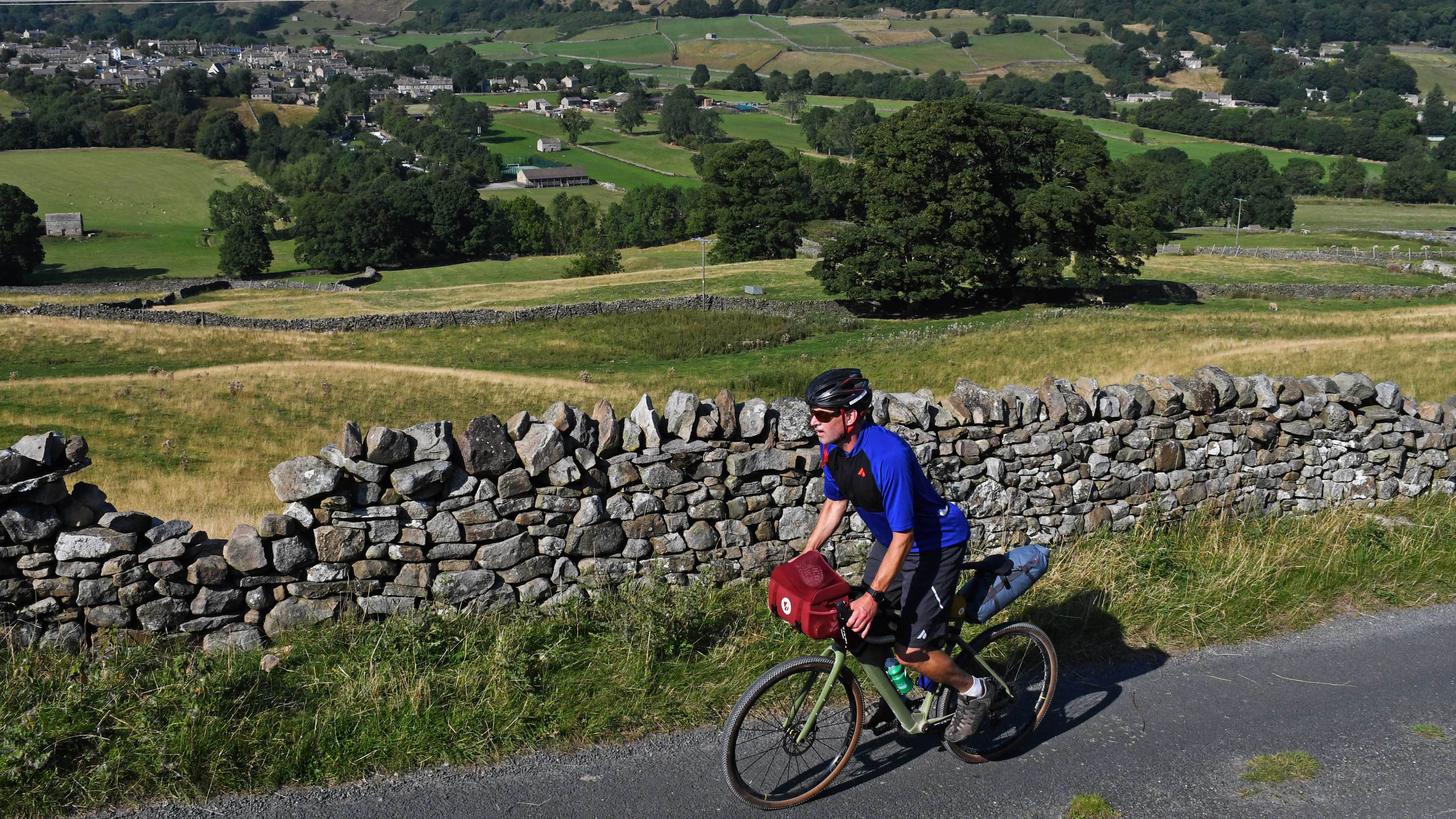
Swale Trail
By the time I rolled out of the brilliant Dales Bike Centre, which I was using as a pre- and after-trip base, the Ribble really looked the business. Pedalling the first section of my route, along the sensational Swale Trail, I glanced down several times with a self-satisfied grin. All my equipment was carefully and tidily packed, and although the bike was now pretty damn heavy, it was also very well balanced. For the first time ever, I felt (and looked) like a real bikepacker.
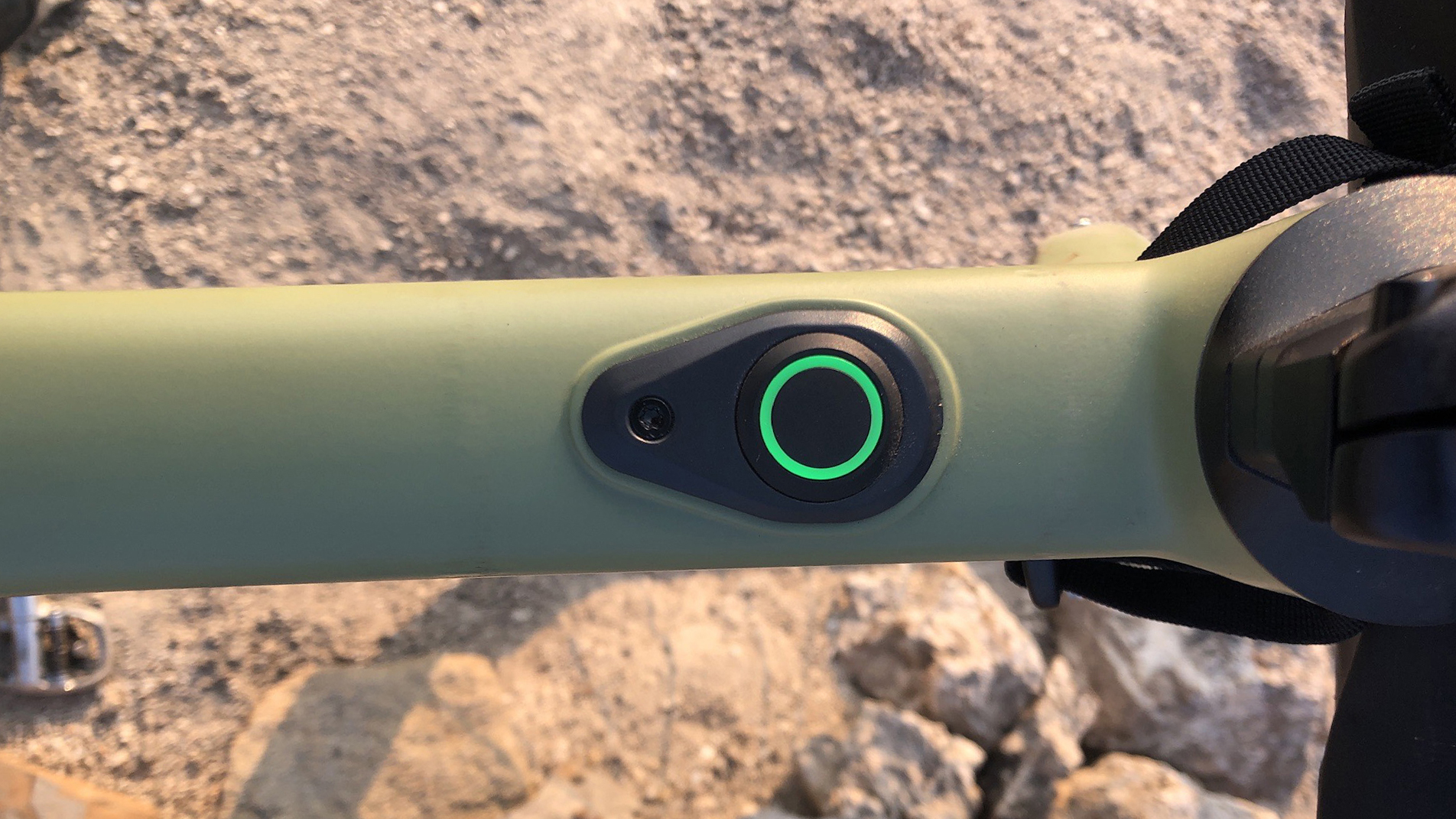
Available from £2,799 (UK) / $2,695.33 (US), the Ribble Gravel AL e is an electric gravel bike, subtly equipped with Mahle X35+ motor, housed in the rear wheel hub and powered by a Panasonic 250Wh battery hidden in the downtube, which supplies up to 250W of assistance to each pedal stroke. Available in several different iterations (I road the 'Sport'), all are designed for long-distance off-road epics.
With a simple, single front ring and internal cabling, the Gravel AL e is a tidy looking bike with a long, low frame and a real gravel-focused finish, from the chunky Halo GXC 650b x 47mm tyres and massive clearance around the forks to the gear ratios, hydraulic disc brakes and the flared drop handlebars, which supply great stability and control during technical descents.
It’s performance orientated, but offers a comfortable ride and it’s easy to use the power options. Pressing an illuminated button on the top tube, you toggle through a sequence of lights indicating the assist level: minimum (green), mid (amber) and maximum (red). This button also indicates how much charge it left in the battery. It’s possible to pair your phone and/or smartwatch with the Mahle SmartBike Systems app to give you visibility of your remaining battery power, plus the speed you’re going and the distance travelled.
SPECS
Weight (size medium): 14.0kg/30.8lbs
Frame: 6061-T6 Heat-treated aluminium
Groupset: SRAM Apex 1x11 Speed
Shifters: SRAM Apex 1 L/H, Apex R/H Hydraulic
Brakes: SRAM Apex HRD Hydraulic Disc
Motor System: MAHLE X35+ 250W
Wheels: Mavic Allroad Disc 650b Alloys
Tyres: Halo GXC 650b x 47mm
Sizes: XXS–XL
Colors: Matte Sage Green
This was also my first real foray on an e-bike of any sort, and I’d been wondering how I would get on with the new tech. After swallowing some initial skepticism in the early years, I’ve been following the rapid evolution of e-bikes with real interest. Once I got my head around the concept that the battery power isn’t necessarily there to provide a helping hand on every hill, but to enable all riders (regardless of skill and fitness levels), to go further, explore more and stay in the saddle during the most viciously vertical ascents, rather than getting off and hiking the bike up the hill, then it all made massive sense.
Gravel e-bikes are still fairly new and relatively rare – several strangers struck up conversations with me about the bike over the weekend – and having the chance to test one out on some proper trails was exciting.
All the latest inspiration, tips and guides to help you plan your next Advnture!
And, as it turned out, I was immediately grateful for the extra oomph I had at my fingertips as I passed through Grinton and began a staggeringly steep climb up the flanks of High Harker Hill. It took me a few minutes to find the right level of assistance – prodding the illuminated button on the front of the frame and toggling through the three power options available as I simultaneously tried to find the right gear – but I eventually settled on the middle one (amber). This left me plenty to do in the pedals, but meant I could get my fully laden bike to the top of the hill without wearing myself out.
At the summit, while pausing to let my breath catch up, I quickly checked the map and discovered I’d missed a right turn at the very bottom, and had climbed the hill entirely unnecessarily. Oh well, at least I’d found out what the e-bike was capable of, and I’d figured out how to use the power-assist system, which is simple and intuitive once you’ve used it once.

Back on track, I followed the lovely lumpy gravel trail through the vale of Swaledale, tracing the serpentine contortions of the eponymous river’s south bank to Gunnerside. Crossing the bridge here, I cycled along the cusp of Melbecks Moor, with the beautiful bumps of Yorkshire Dales National Park rising to my right and the river rushing along on my left.
Close to an old lead mine the track dipped around a hairpin bend and swung across Swinners Gill via a rough and rocky ford below a footbridge. Splashing through the fast flowing water on slippery stones tested both my bike-handling skills and the grip of the Ribbles’ Halo GXC tyres, but we both passed with aplomb. And I was able to stay in the saddle for the savagely stiff climb up Bracken and Stony Hills too, which reared up immediately after the ford crossing, with a little assistance from the Ribble’s Mahle motor.
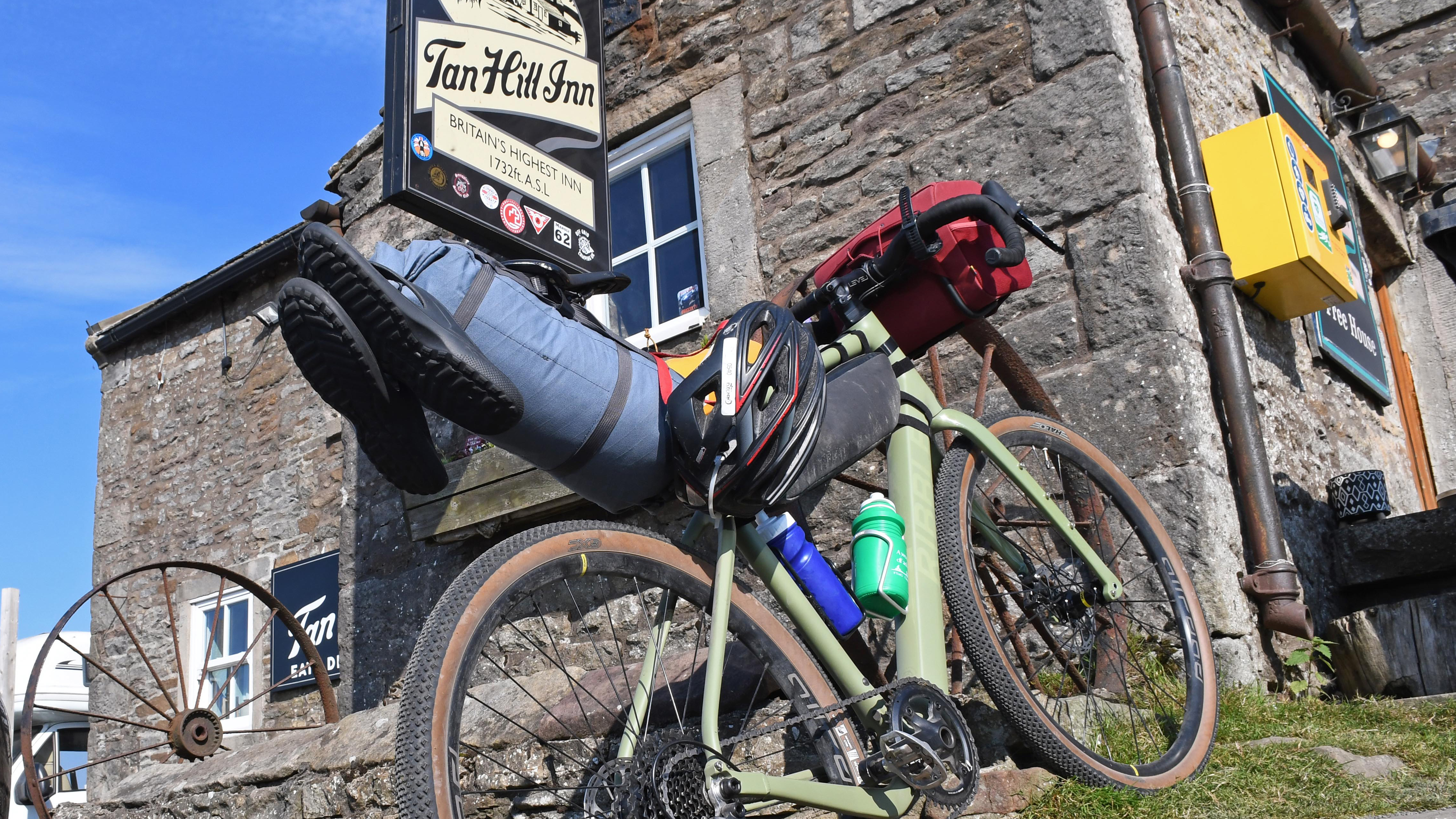
Pedalling to the loftiest pub in the land
At a fork in the path just before Keld, my mission took me off the Swale Trail, away from the river and up on to Black Moor, along a cyclable section of the Pennine Way. I was on an official bridleway, but the riding quickly turned tough as the track became really rough and rugged, sending me across multiple gaping gills and through dozens of deep ditches, and I was grateful for the extra e-push on some of the more nuggety ascents. The beauty of the Mahle motor is that it only engages and provides torque when you’re pedalling, so if you have to put your feet down at any stage, on a technical bit of trail, the bike doesn’t try and take off without you.
My objective was the Tan Hill Inn, England’s highest pub and a legendary pitstop for Pennine Way wanderers and bikepackers exploring the Dales. But, by the time I reached the brow of Low Brown Hill the sun was already sinking and I began to fret that I wouldn’t get there before nightfall. That wouldn’t have been the end of the world, I was carrying shelter and supplies, but exploring this unique pub was definitely part of my plan. So, putting my head down and my camera away, I gunned it across Stonesdale Moor and over Lad Gill Hill, from the top of which I let out a whoop of relief after spotting the roof of the iconic establishment, just at the end of a sweet section of singletrack stretching out before me.
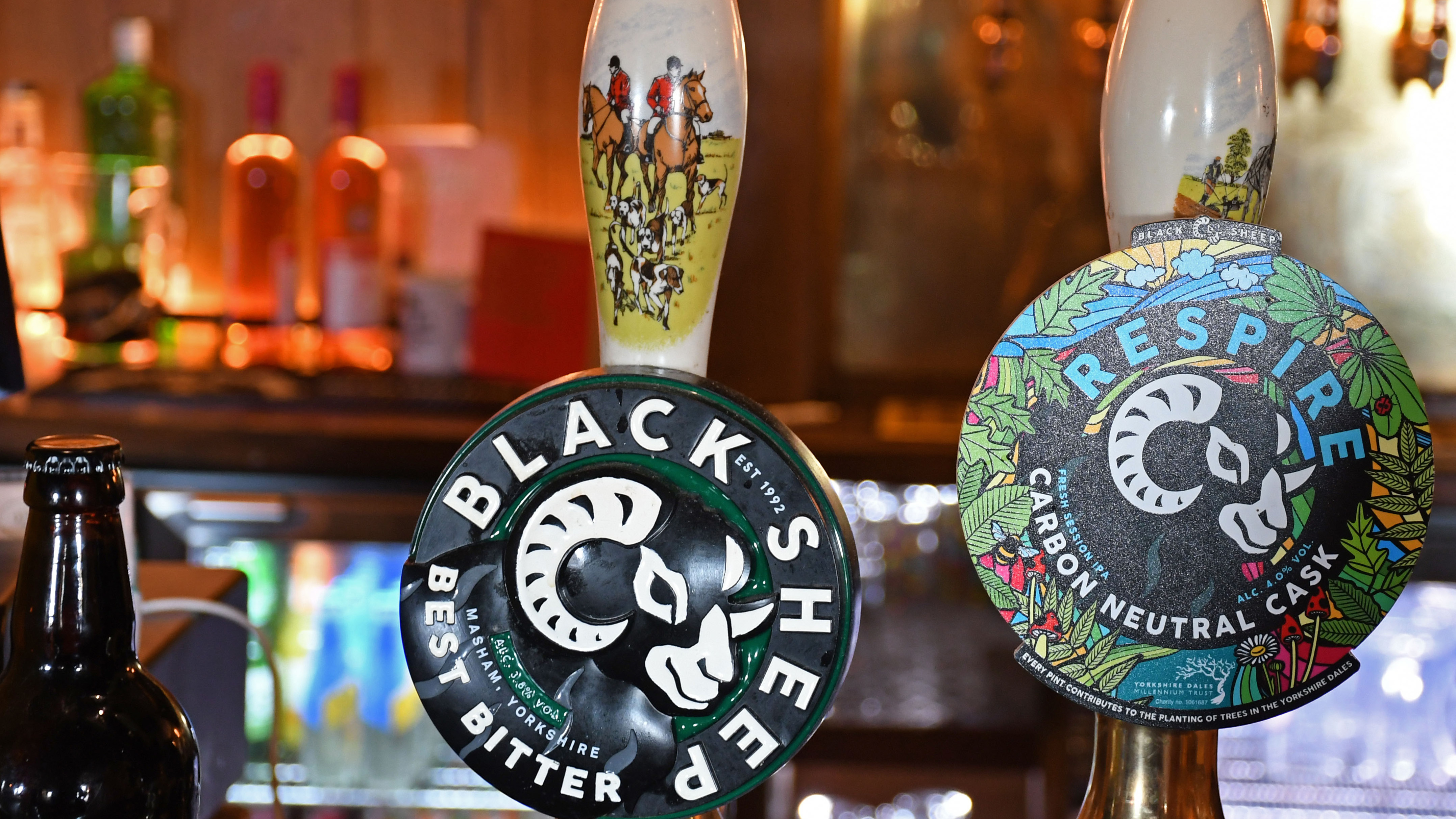
Big night out
For a nominal fee, camping is allowed on the open moorland around the inn, a lofty oasis that occupies a remote and lonely little plateau betwixt Sleightholme and Stonesdale moors, 528 metres above sea level, with panoramic views across the dales. Quickly, I scoped out a nesting spot amid the boulders, strung up my tarp, laid out my bivvy, sleeping bag and mat, and secured my bike before scuttling off in pursuit of a pint and a pie at the pub.
Surprisingly, given how remote we were and the lateness of the hour, the place was buzzing. A live band was in full swing and a colourful ensemble of bikers, hikers and campervanners were swinging, singing and slurping beers.
One Friday evening back in December 2021, a surprise snowstorm trapped 61 people in the Tan Hill Inn for three whole days. I remembered listening to these prisoners of winter when they were interviewed live on the radio, via a phone line, and a happier huddle of hostages you could not have imagined. They were busy working their way through the stock, and sounded in no rush to be rescued. There would be no such luck for me, though. I was literally there on the hottest night of the year, and when I left the bar to wander back to my bike and bivvy spot, the Milky Way was splattered bright across the sky above the ink-dark dales.
Beyond the bike, the essentials for any bikepacking trip are a lightweight tent, or better still a tarp or hammock; a lightweight sleeping bag; an inflatable sleeping mat; and a compact camping stove.
The evening was so balmy I dispensed with the tarp so I could drift off while staring at the stars, and barely needed to zip myself into my sleeping bag. And when the dawn light started creeping across the dales it revealed another bluebird day in the making.

My Jetboil heated water for a morning brew and a bowl of porridge in a few seconds, and then I set about getting everything packed and strapped back on the bike. Once you’ve got a system going, it’s quick and easy to break camp when you’re bikepacking, because you’ve already whittled down your kit to the bare necessities.
Remounting the Ribble, I rolled down the track away from the Tan Hill Inn and by 9am I was enjoying a morning swim in the River Swale, happily wallowing below the waterfalls around Kisdon Force, near Keld.
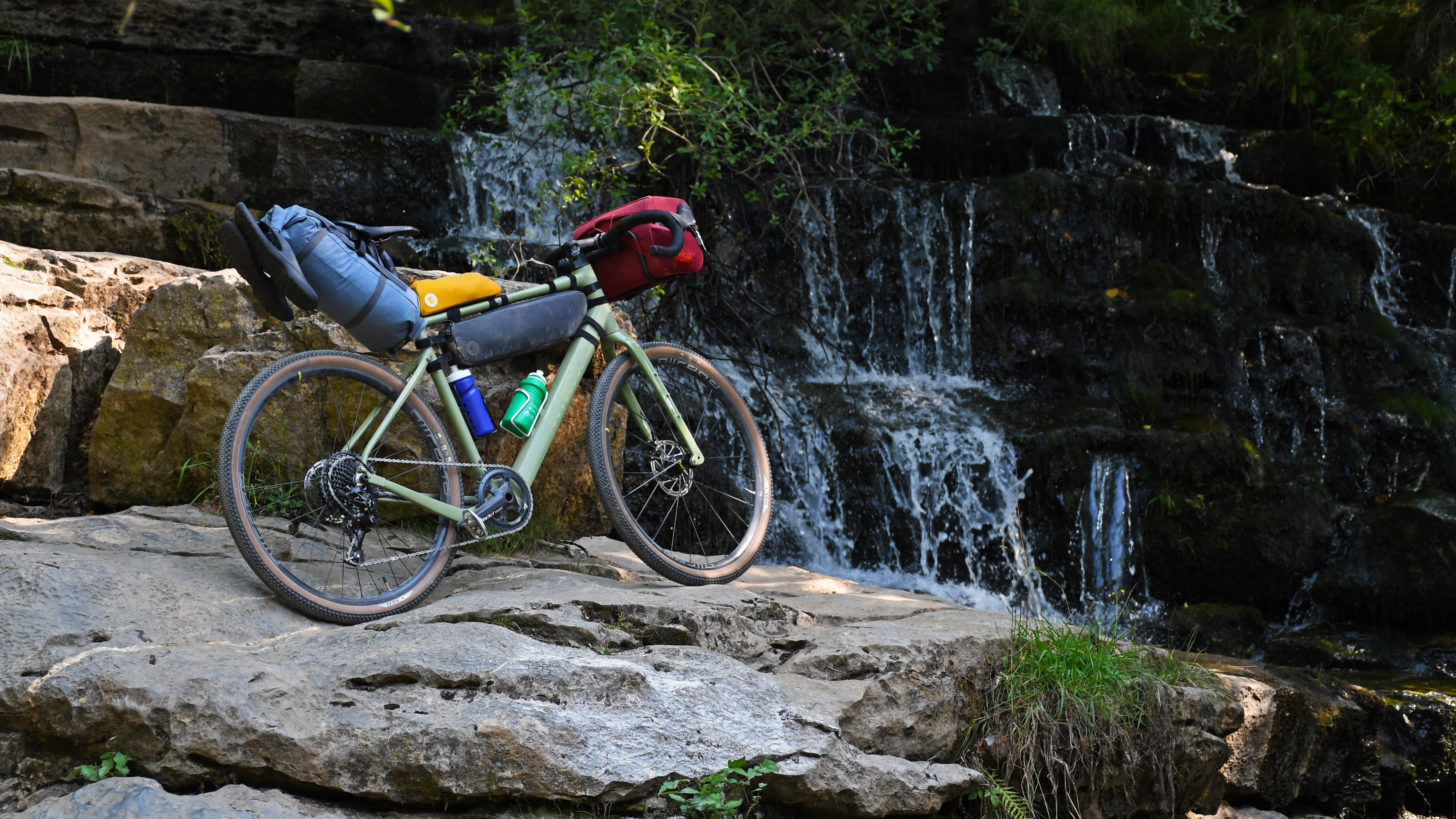
It was a pretty easy ride back towards the Dales Bike Centre on lanes, roads and rubbly trails through Swaledale, ambling along, unencumbered by a backpack, with plenty of juice left in the bike battery for a cheeky cheat on the steepest climbs en route.
In fact, I had far too much left in the tank to call it a day when I got to the end of the Swale Trail. The light gauge on the bike showed plenty of charge remained, my legs had a few miles left in them, and there was much more high moor to explore.

Gravel rush
I dumped my camping kit at the bike centre, swapped the larger frame bags for a couple of smaller pouches that I hastily stuffed with snacks and extra layers, and then set off up along Arkengarthdale, be the side of Arkle Beck, before veeting left on to Reeth High Moor. Here, Stuart from the Dales Bike Centre had told me I’d find a some real gravel to razz the Ribble around on, and he wasn’t wrong. It was a surreal landscape, with tracks of loose grey grit spidering out across an expanse of purple flowering heather.
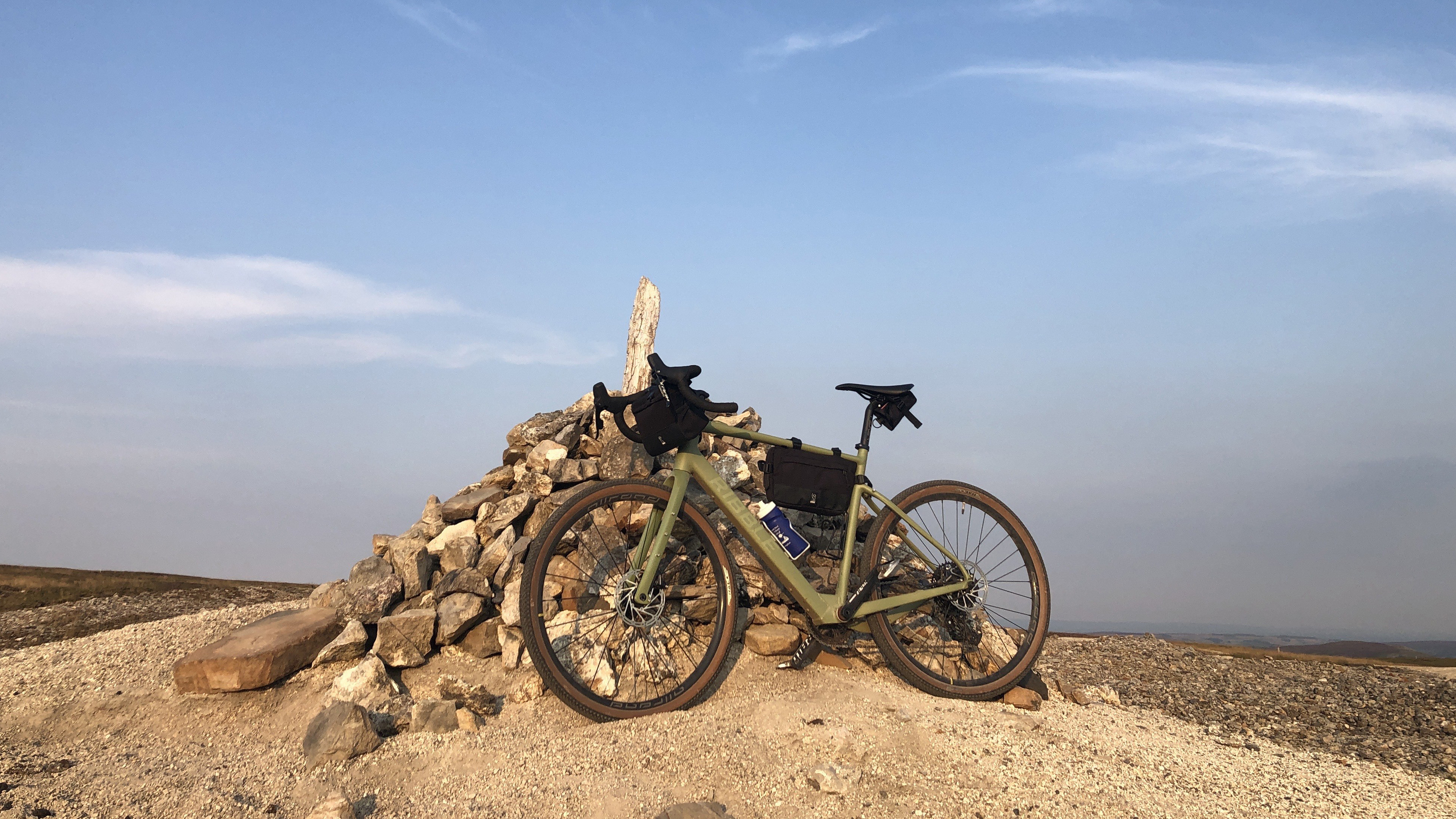
I rode to the dusty peak of Great Pinseat, where a little cairn was perched on the 583-metre summit surrounded by a moonscape of rubbly mounds. This is the exact terrain gravel bikes are built for, and during the subsequent descent the Ribble’s tyres bit into the grit and kept me upright as I leaned into tight turns, swooping and whooping around seemingly endless bends before leveling out along Barney Beck.
Clouds of dust billowed out behind me, and every few hundred metres grouse would emerge from grass, red eyebrows raised in alarm, chattering and chuntering furiously to one another about the rude interruption to their evening.
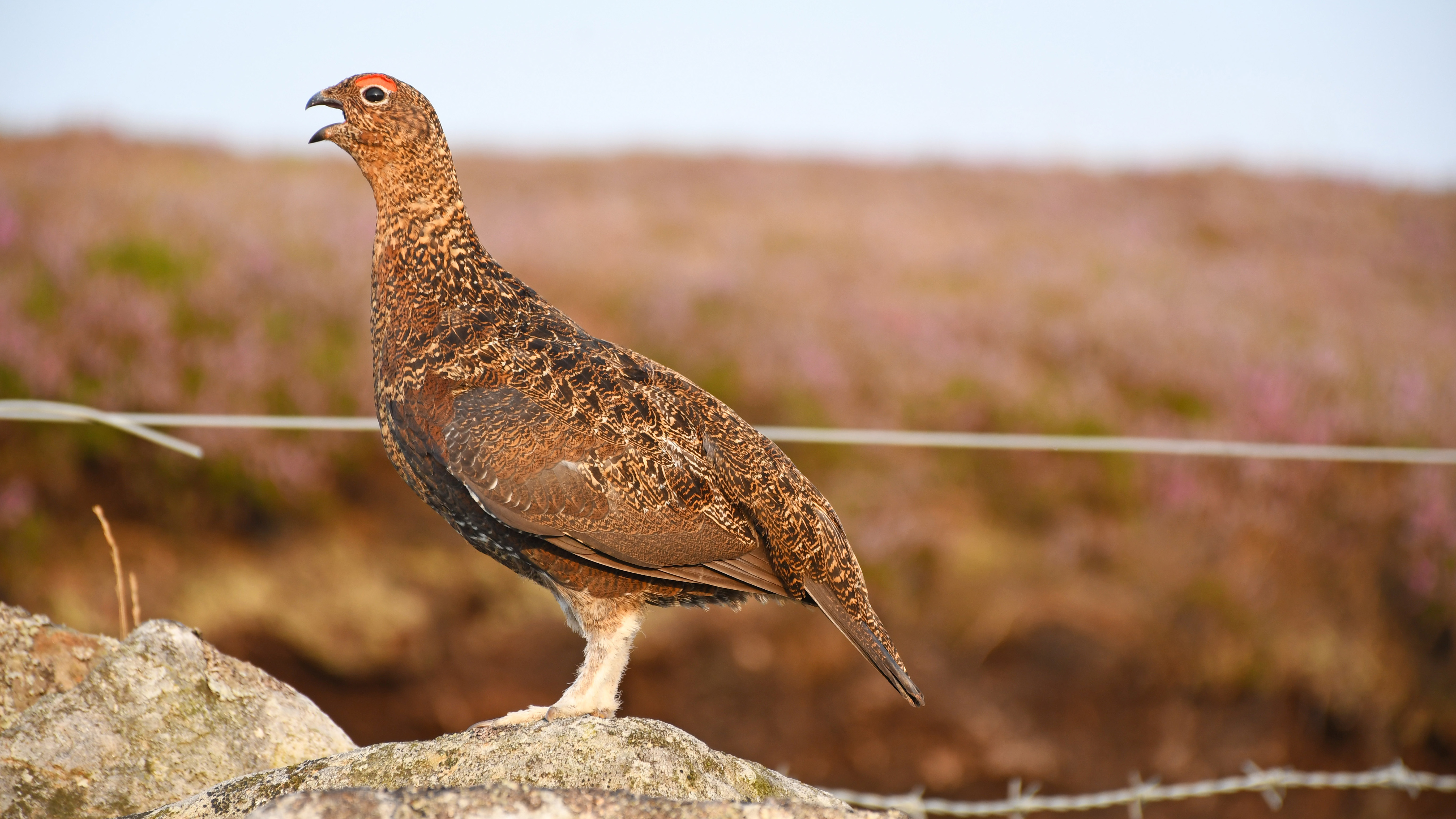
I had the place to myself and couldn’t resist razzing the Ribble around Reeth Moor for a little while longer. The setting sun was casting long shadow across the floor of the moor by the time I realised my legs were whinging, and the bike battery level indicator light was on amber. Luckily, it was downhill all the way to Reeth and Grinton, so swapping gravel for gravity I rolled back to base. But by the time I reached civilization, all the village pubs had stopped serving food. Lost in the enjoyment of the ride, I’d forgotten it was a Sunday.
As a result, my recovery feast took the form of a packet of peanuts, a pickled egg and a pint of Black Sheep, but luckily it was far easier to recharge the bike than it was to refill my body. Back at the Dales Bike Centre I plugged the Ribble in, got the map out and started planning the next day’s adventures.
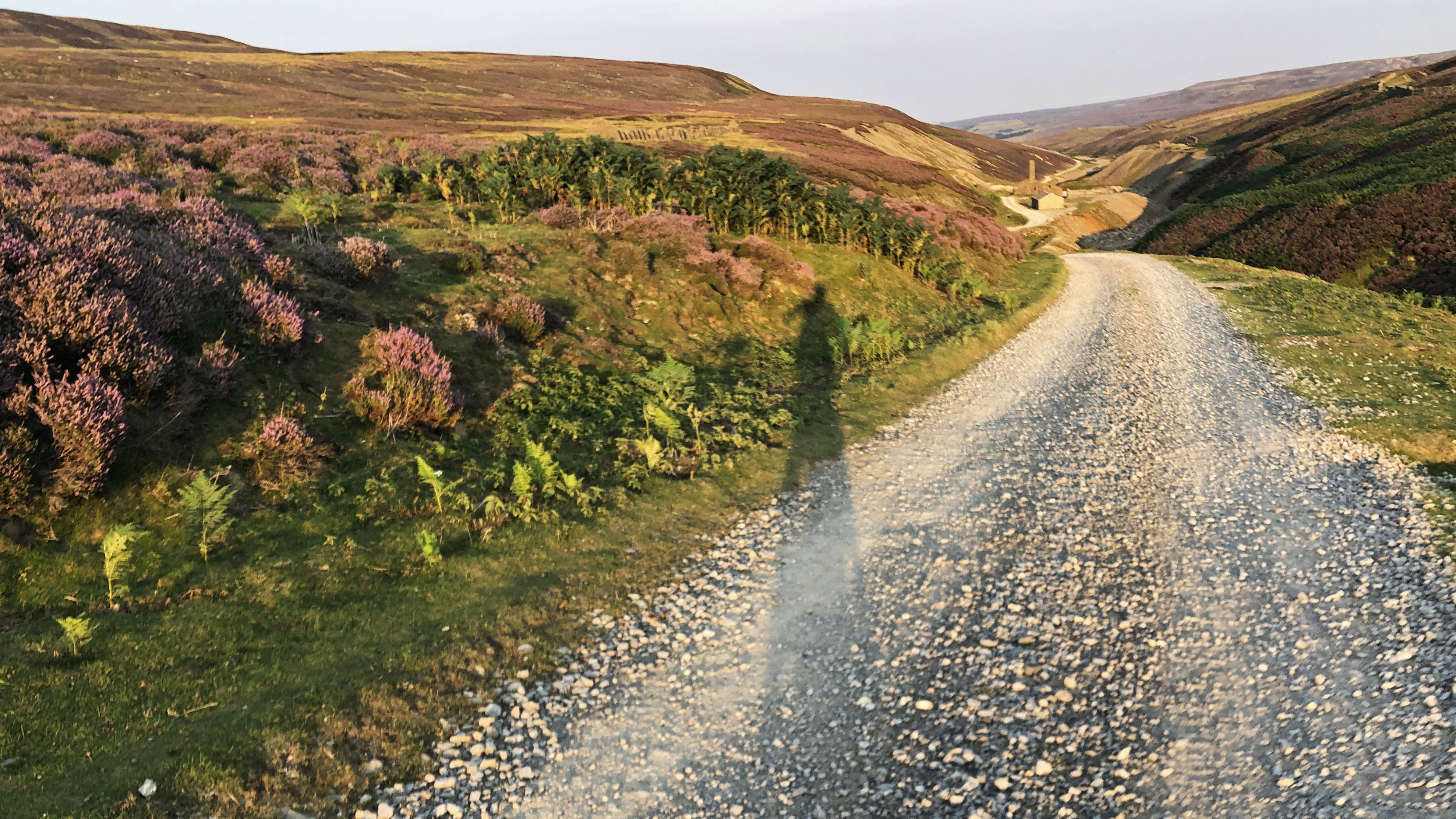
- 10 backpacking essentials: the ultimate checklist

Author of Caving, Canyoning, Coasteering…, a recently released book about all kinds of outdoor adventures around Britain, Pat has spent 20 years pursuing stories involving boots, bikes, boats, beers and bruises. En route he’s canoed Canada’s Yukon River, climbed Mont Blanc and Kilimanjaro, skied and mountain biked through the Norwegian Alps, run an ultra across the roof of Mauritius, and set short-lived records for trail-running Australia’s highest peaks and New Zealand’s Great Walks. He’s authored walking guides to Devon and Dorset, and once wrote a whole book about Toilets for Lonely Planet. Follow Pat’s escapades on Strava here and Instagram here.
